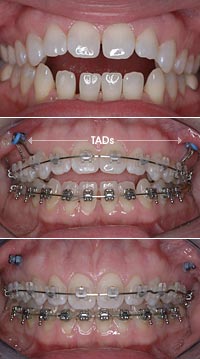
Temporary Anchorage Devices
Orthodontic movement of a tooth includes three components: the active tooth (the tooth we want to move); the force module, (which could be a combination of a spring, a wire, or elastic); and an anchor for the opposite end of the force. TADs or temporary anchorage devices deal with the third component.
The American Association of Orthodontists (AAO) defines anchorage as “Resistance to activation force. Anchorage may come from any of the following sources: intraoral-teeth; bone and soft tissue; extraoral-cervical, occipital, cranial.” Extraoral anchorage refers to different types of headgear.
Of the anchorage categories listed by the AAO, teeth are the most commonly used anchor. While teeth are convenient anchors, they present significant limitations when used as anchors. The major limitations are:
- Stability – when a tooth is used as the anchor, the anchor tooth moves as well. Anchor tooth movement is usually undesirable.
- Vector or position – when a tooth is used as an anchor, force application is limited by the healthy positions of teeth.
According to the definitions of the AAO, bone anchorage is often the best form. In the past, the use of bone anchorage was limited due to expense and complexity of placement. However, newer Temporary Anchorage Devices are safer and less expensive.
A TAD is a device fixed to bone specifically for the purpose of providing orthodontic anchorage and is removed at the completion of treatment.
TADs can:
- Stabilize a tooth being used as an anchor
- Eliminate the need to use a tooth as an anchor
- Provide an anchorage point where tooth anchorage is not normally available
Orthodontics with TADs can:
- Reduce orthodontic treatment time by one third
- Eliminate the need for a headgear
- Provide a more ideal finish
- Allow limited tooth movement in preparation for a bridge, crown or implant without braces
- Close most open bites without surgery
- Eliminate the need for rubber bands
TADs are typically placed in the orthodontic office and do not require an additional specialist referral.
A TAD is an implant that is fixed to bone for the purpose of providing an absolute anchorage point for movement of teeth. TAD�s are removed and discarded at the end of orthodontic treatment.
In conventional orthodontic treatment, there are often unwanted tooth movements that occur when certain movements are attempted. TAD�s allow us to move only the teeth that we want to and thus help to not only shorten treatment but also to accomplish goals that are not achievable with regular braces.
A TAD is capable of:
- Replacing a headgear
- Closing a mild open bite
- Opening a deep bite
- Correcting a Class II
- Correcting a Class III
- Correcting an occlusion asymmetry
- Uprighting a tipped molar in preparation for restorative without full braces
- Intruding or extruding teeth for restorative procedures usually without full braces
- Correcting a single tooth crossbite without full braces
- OGS can be simplified to one jaw
- TADs are good fixation points to manage post-OGS patients
TAD’s do not work for every patient but in many cases, they shorten treatment and improve our final result.